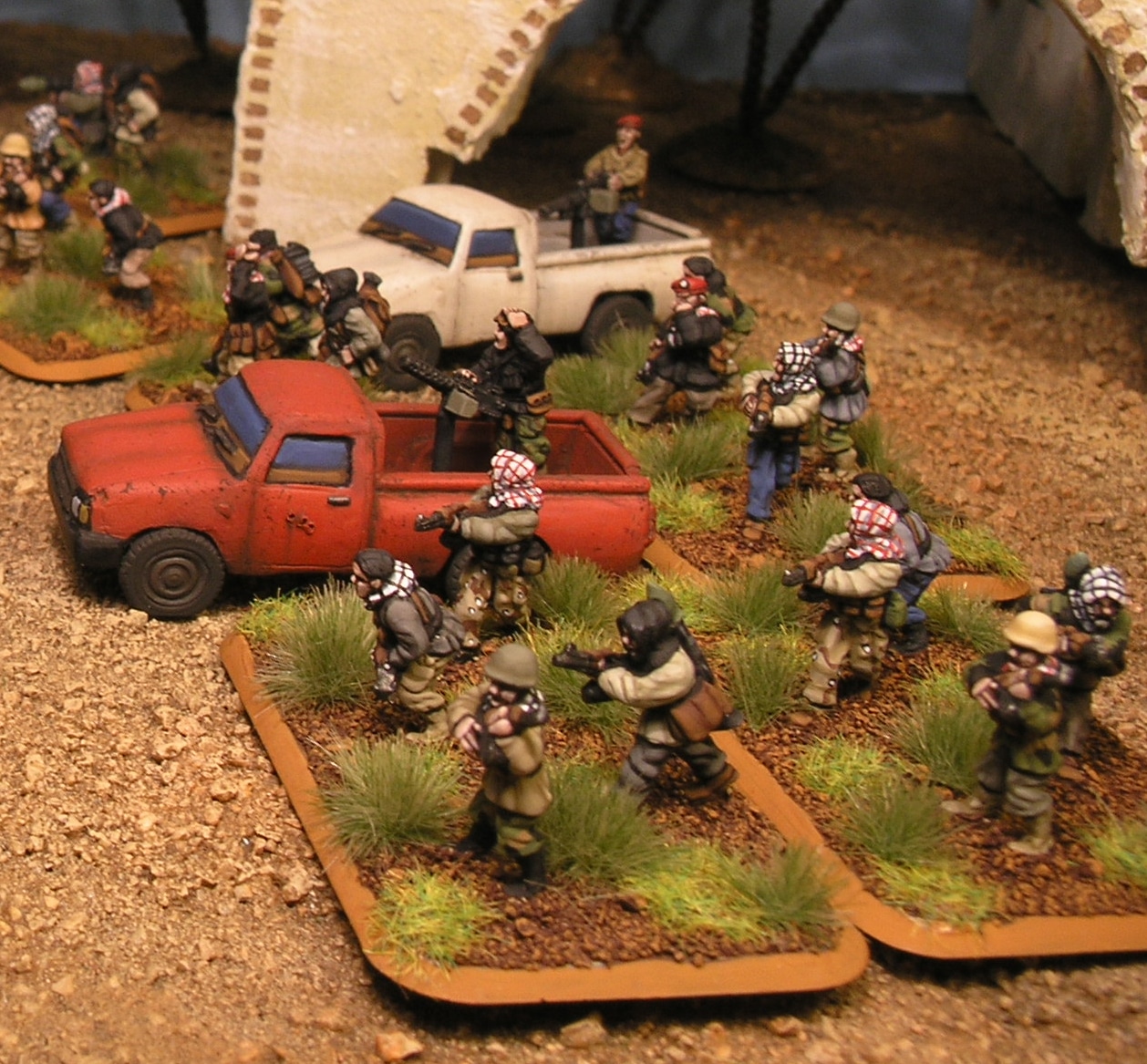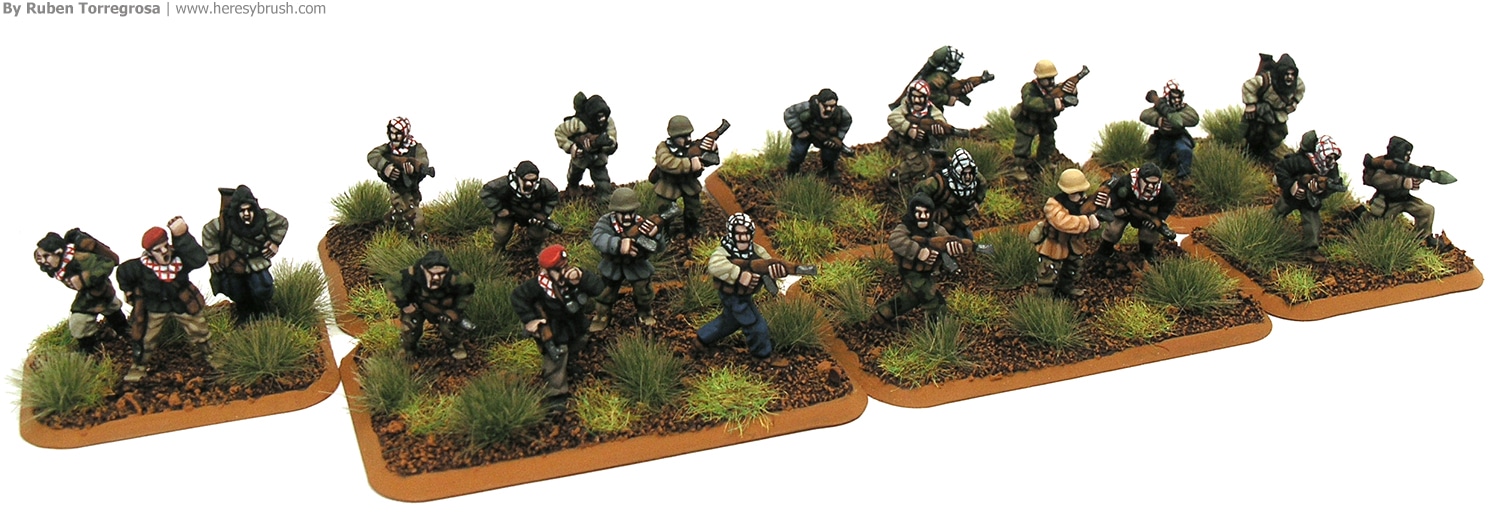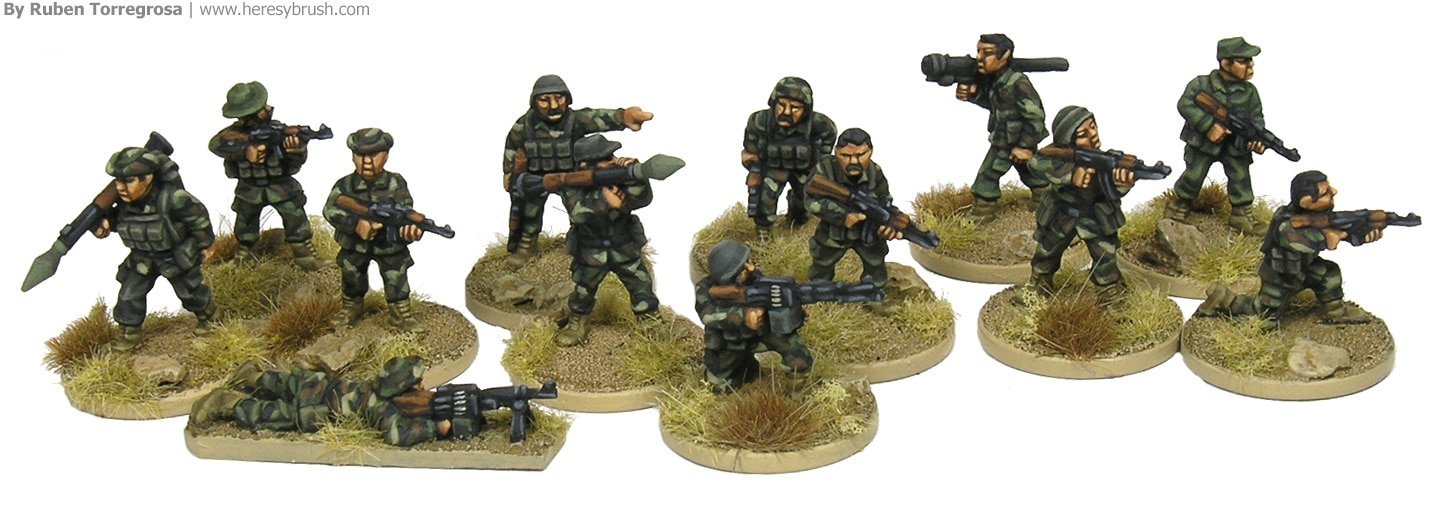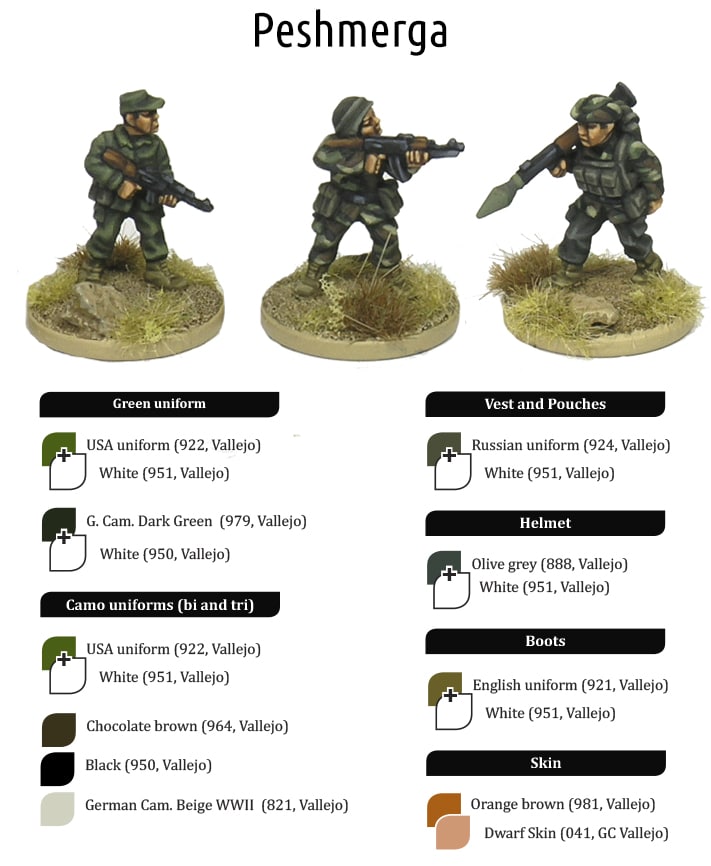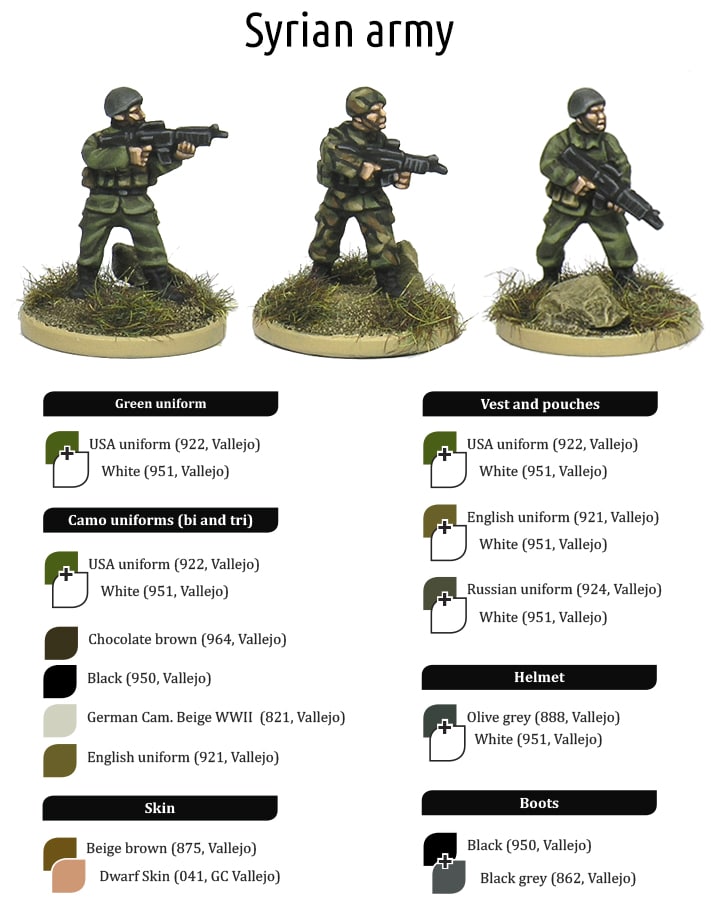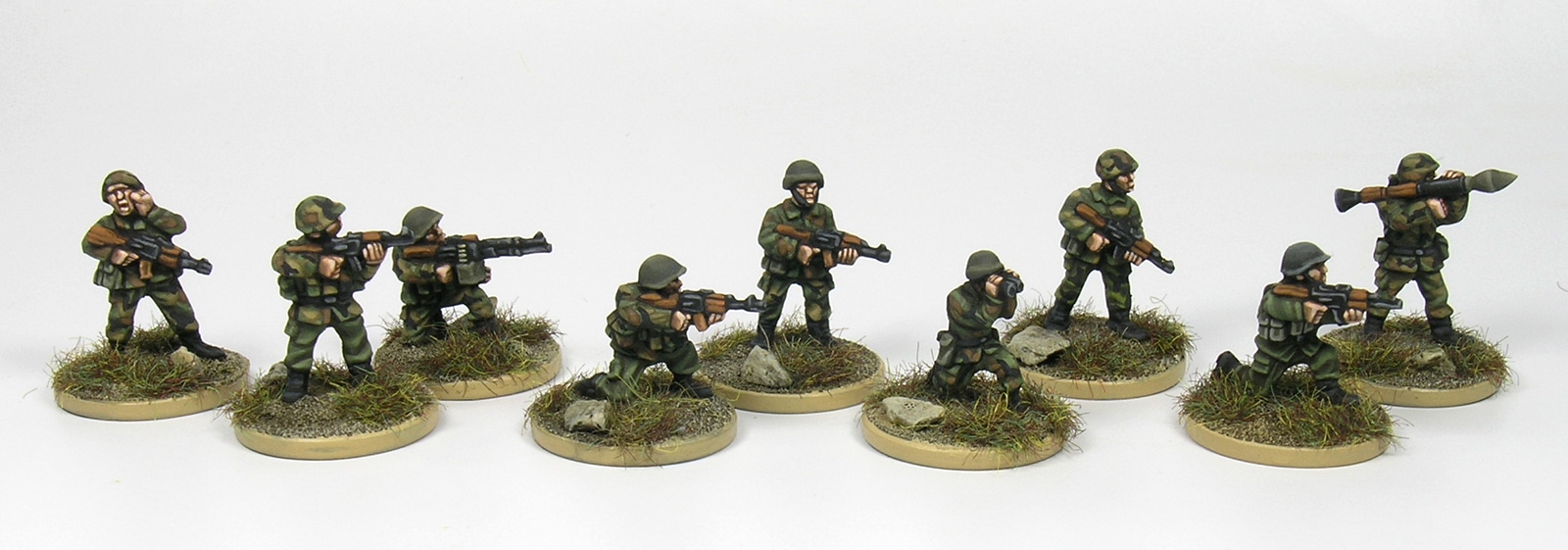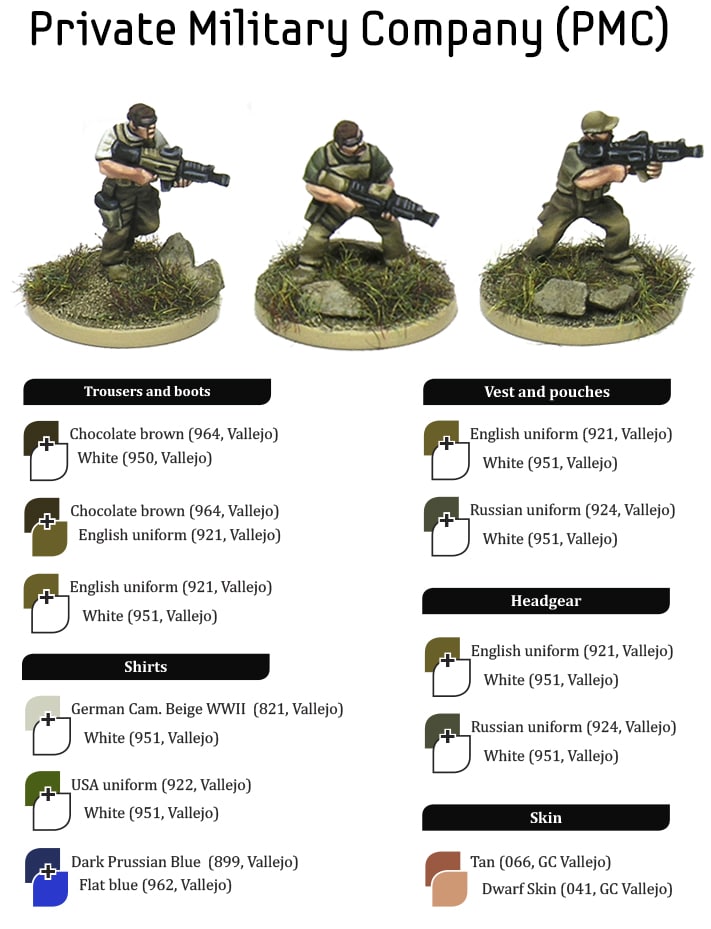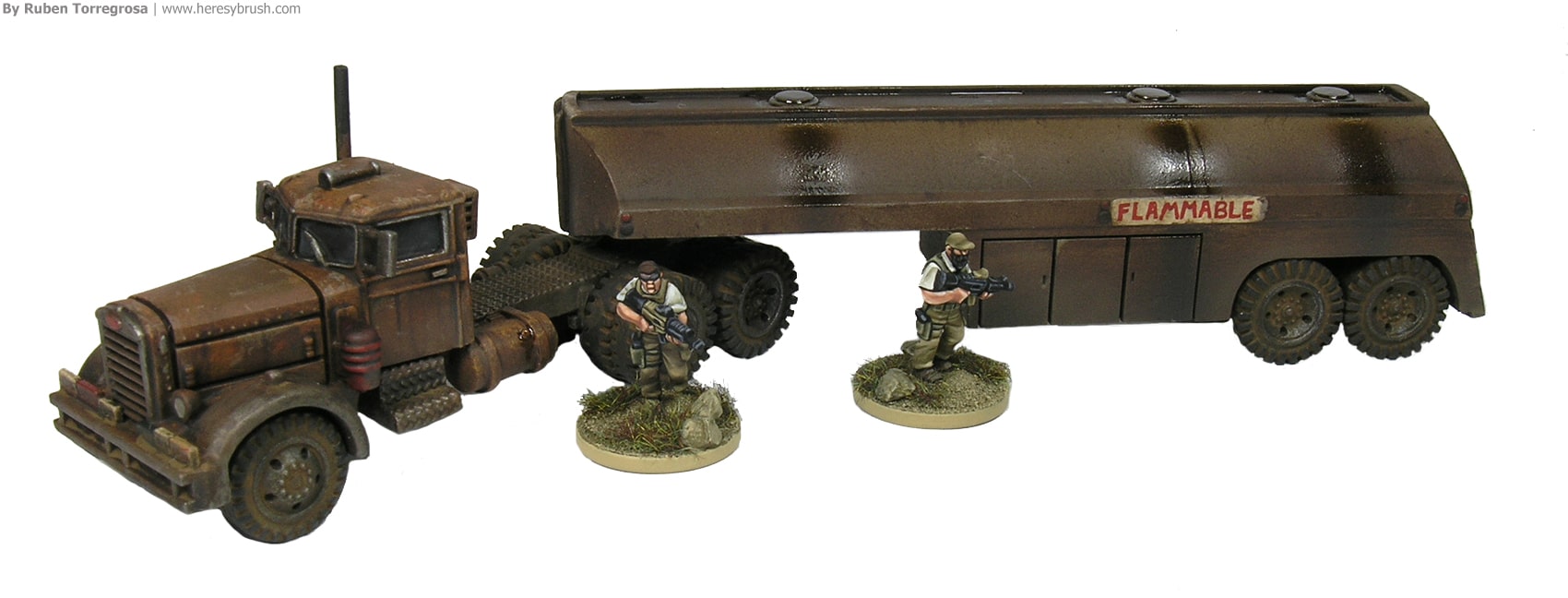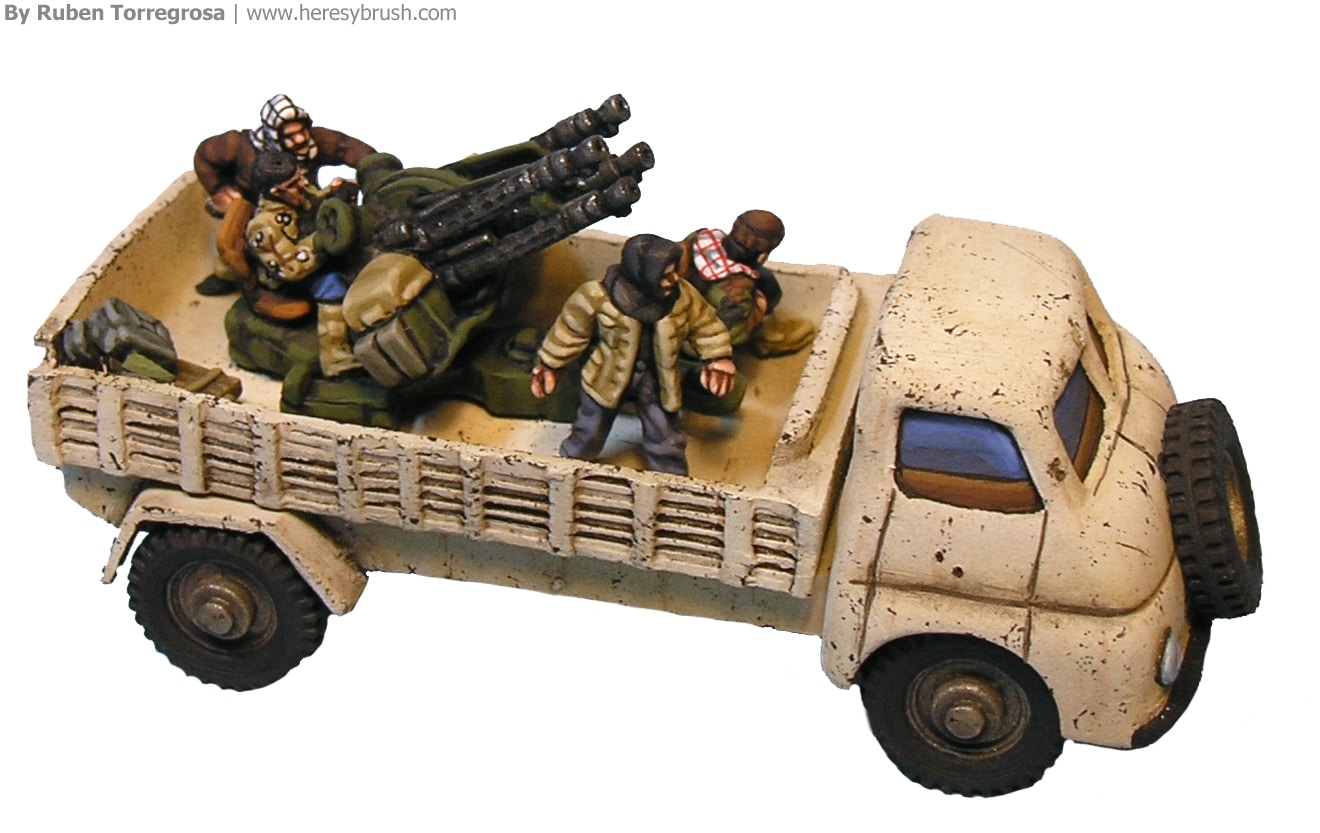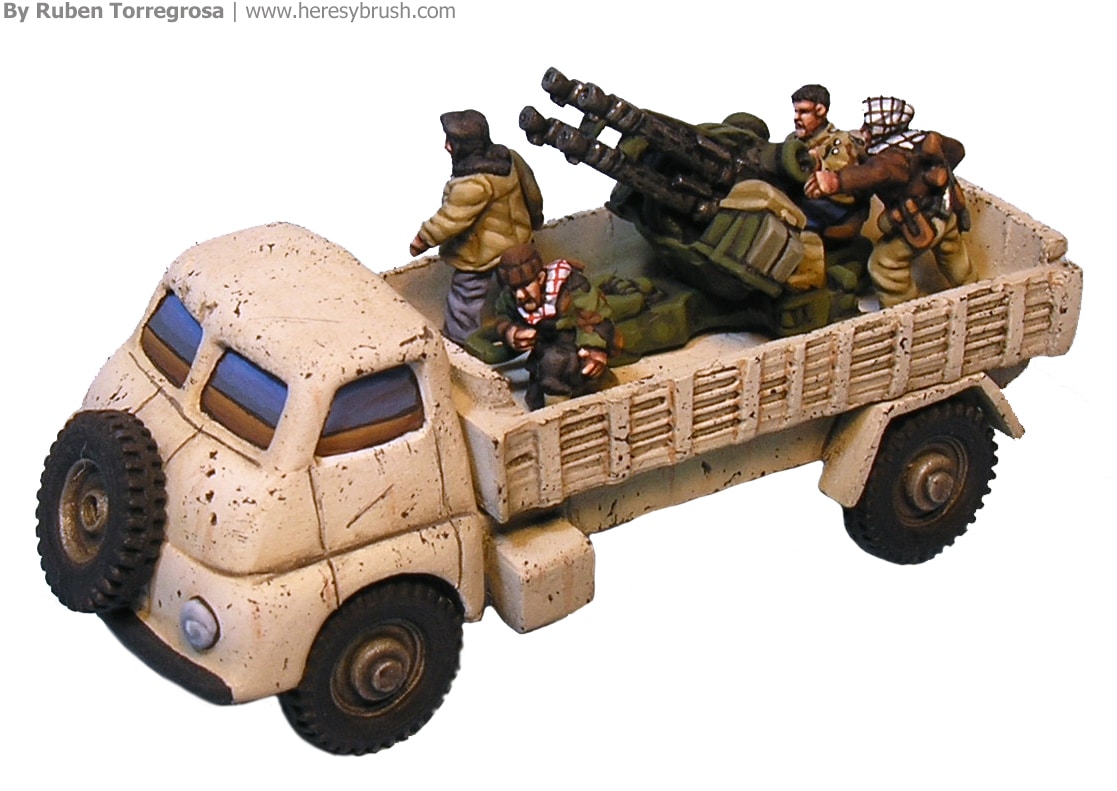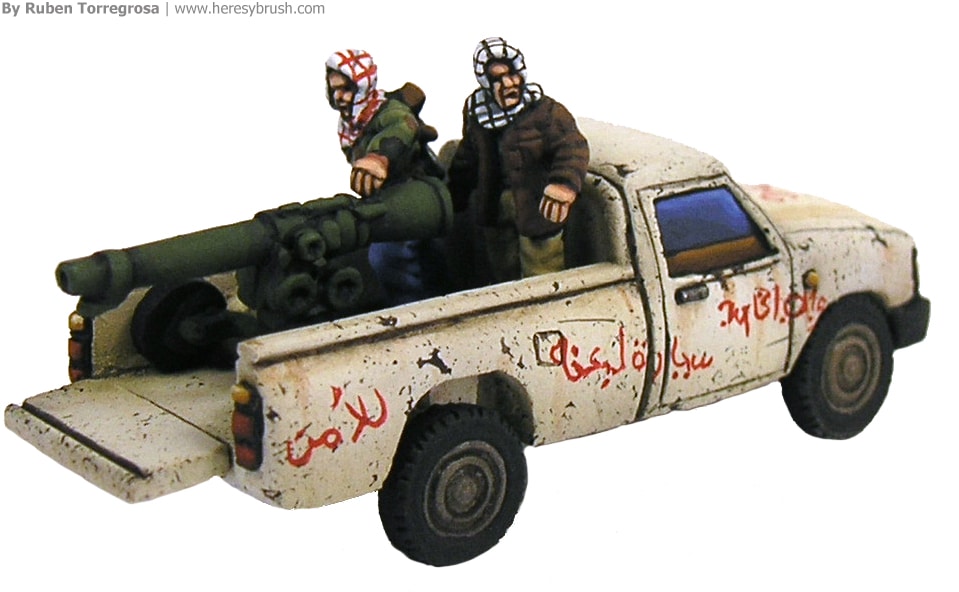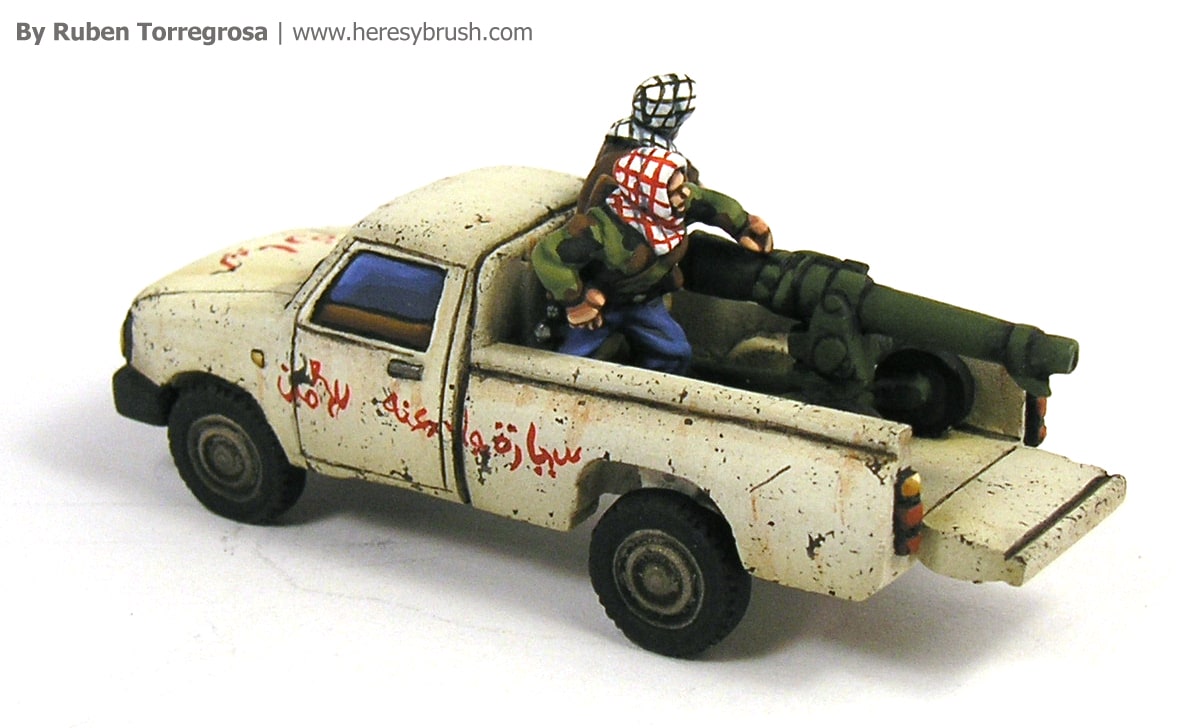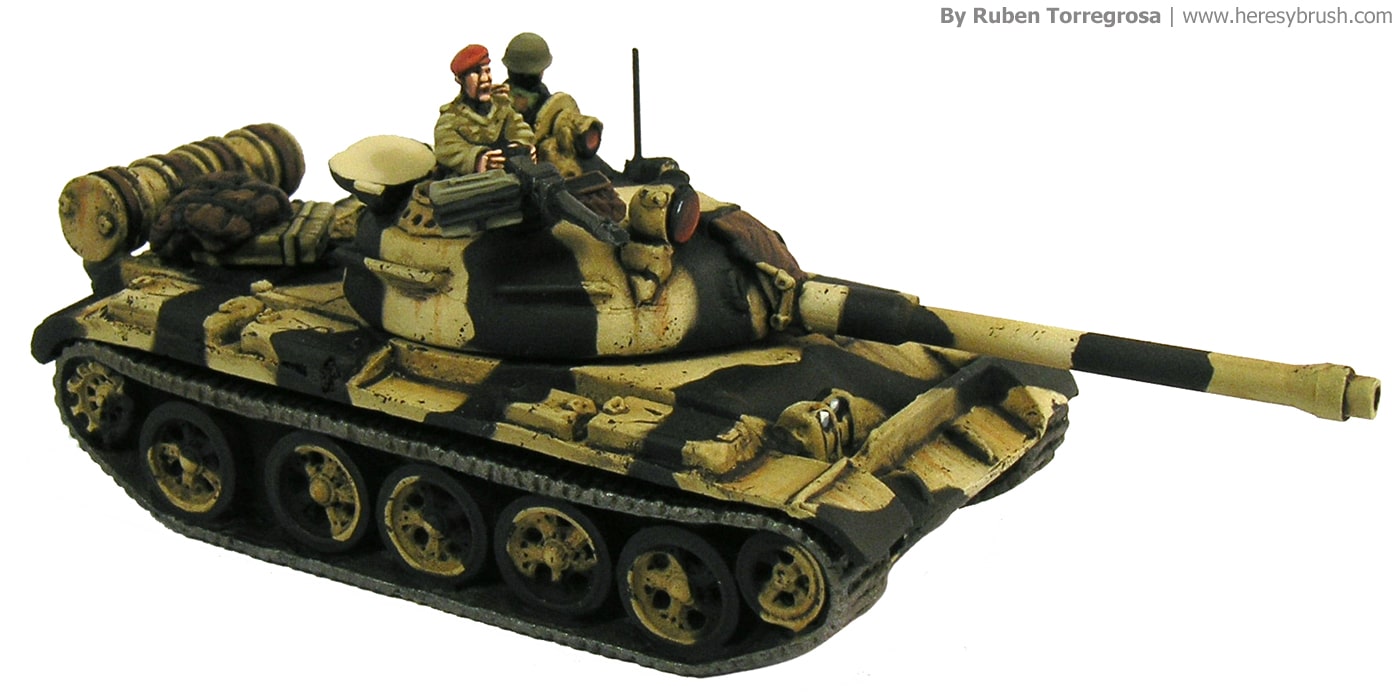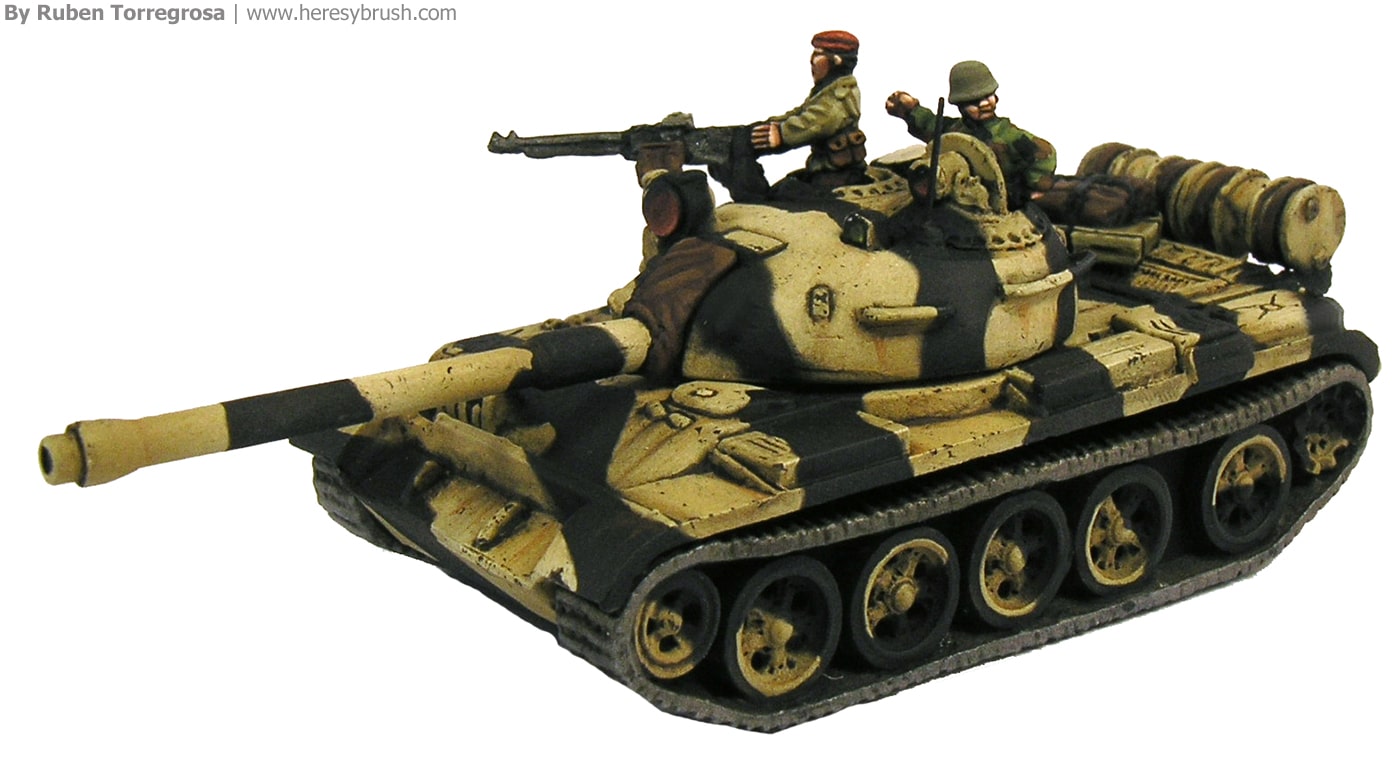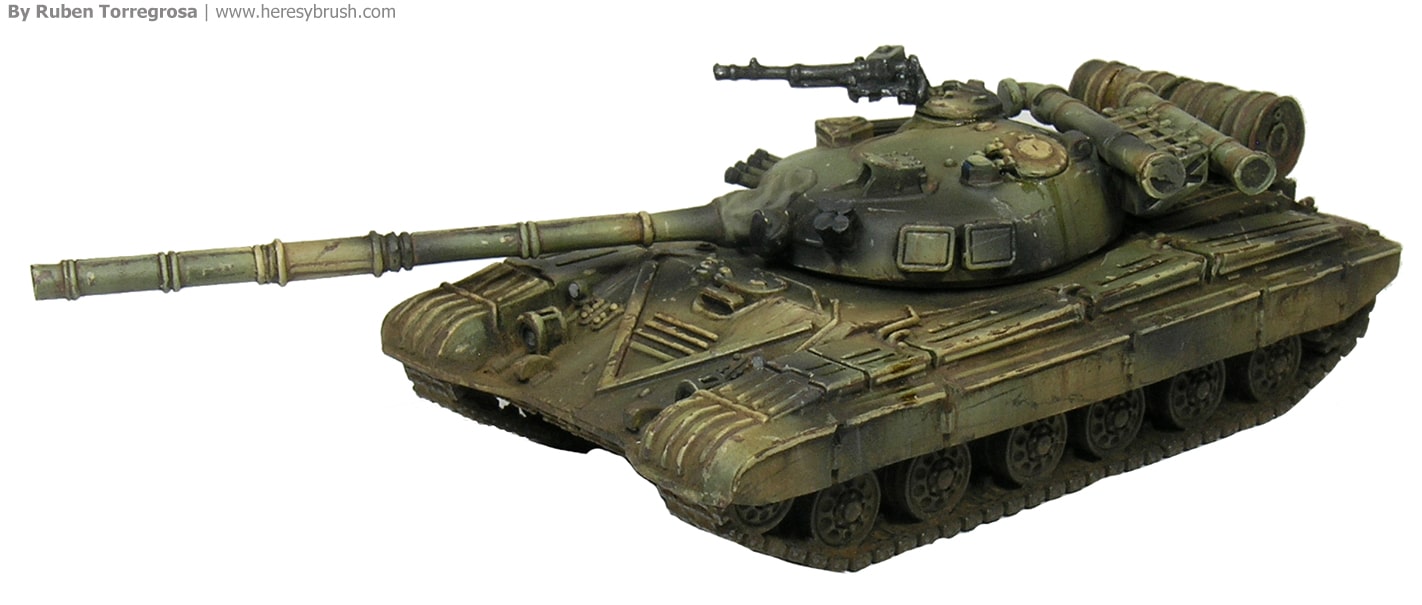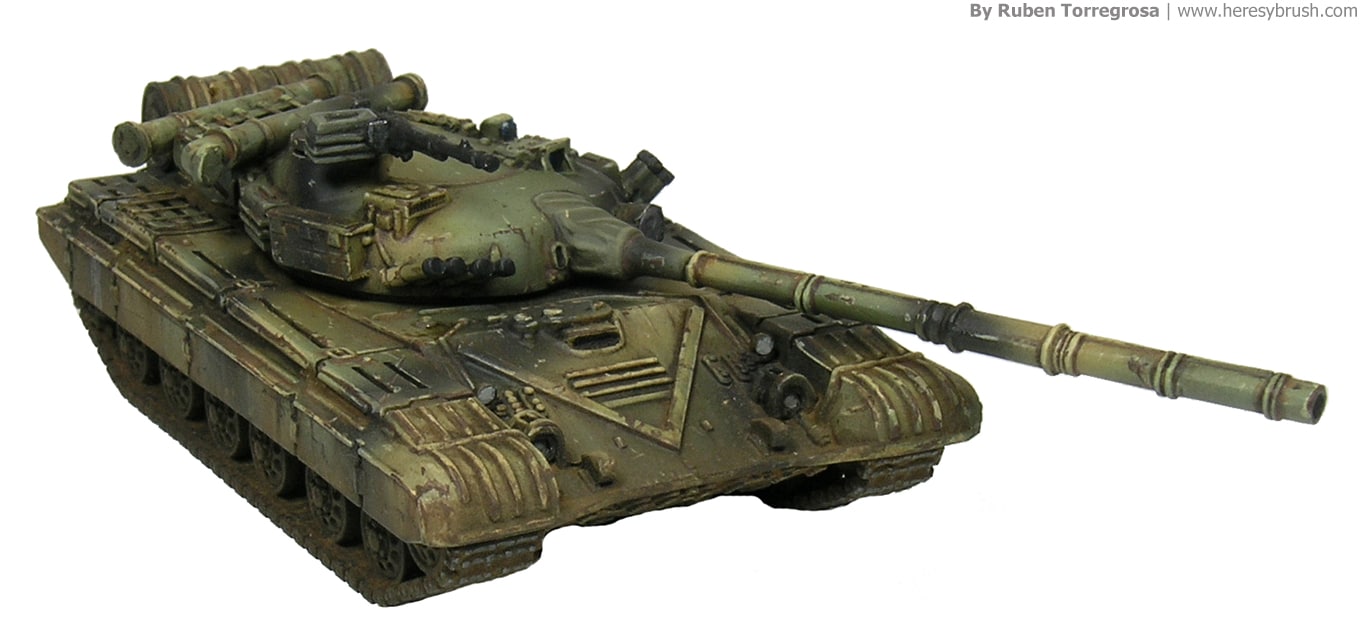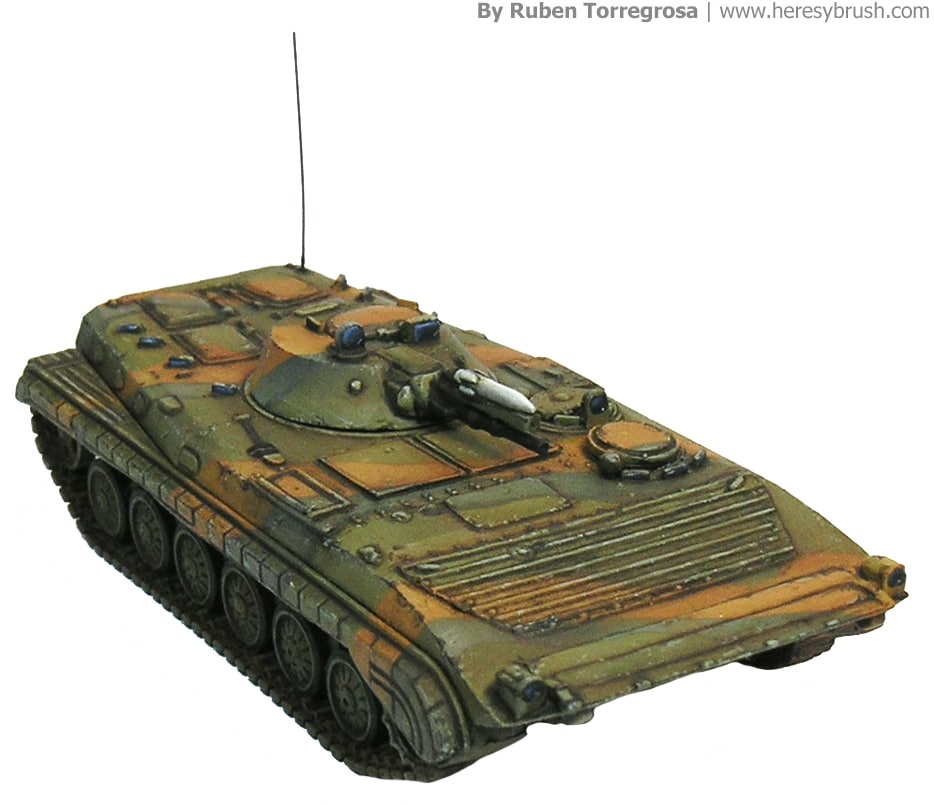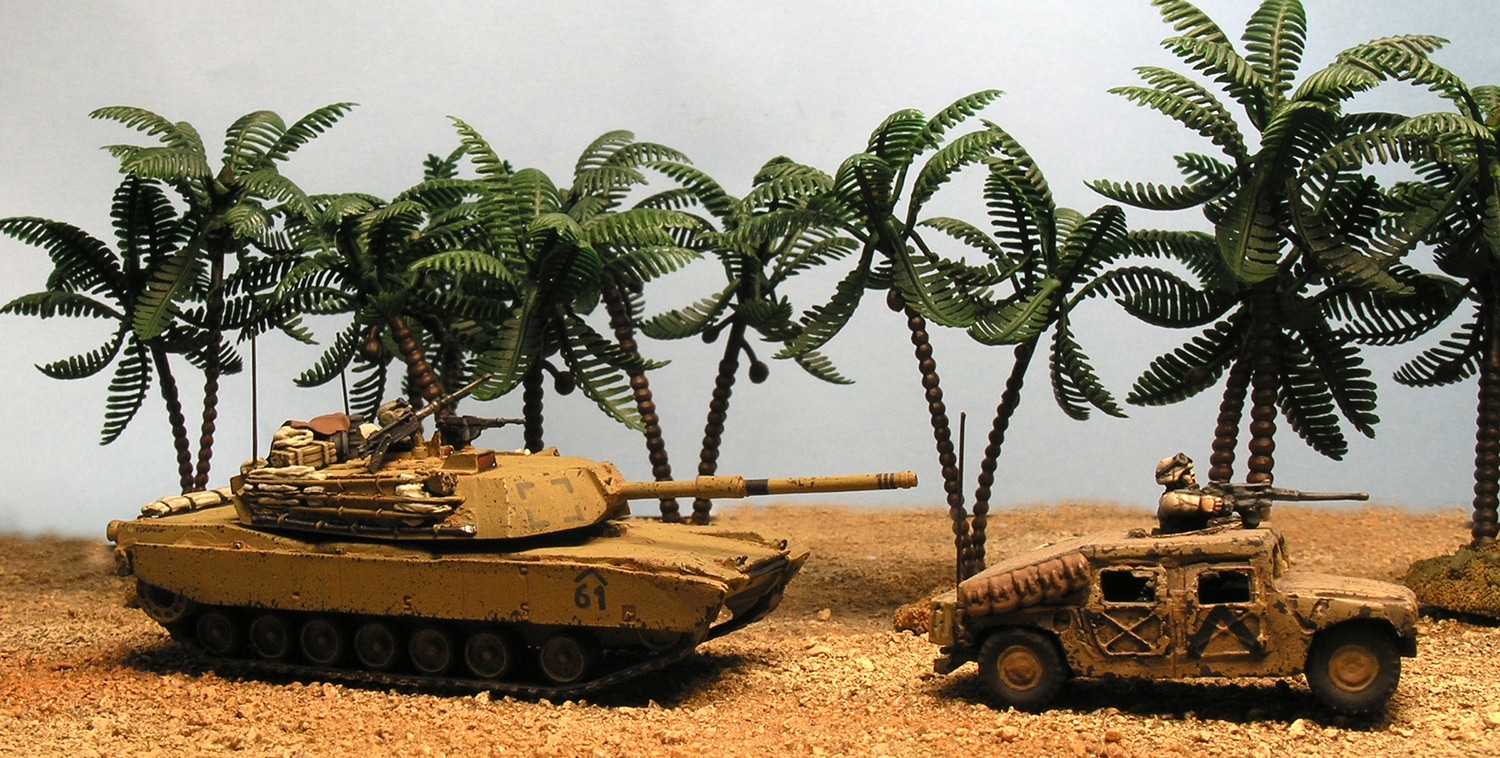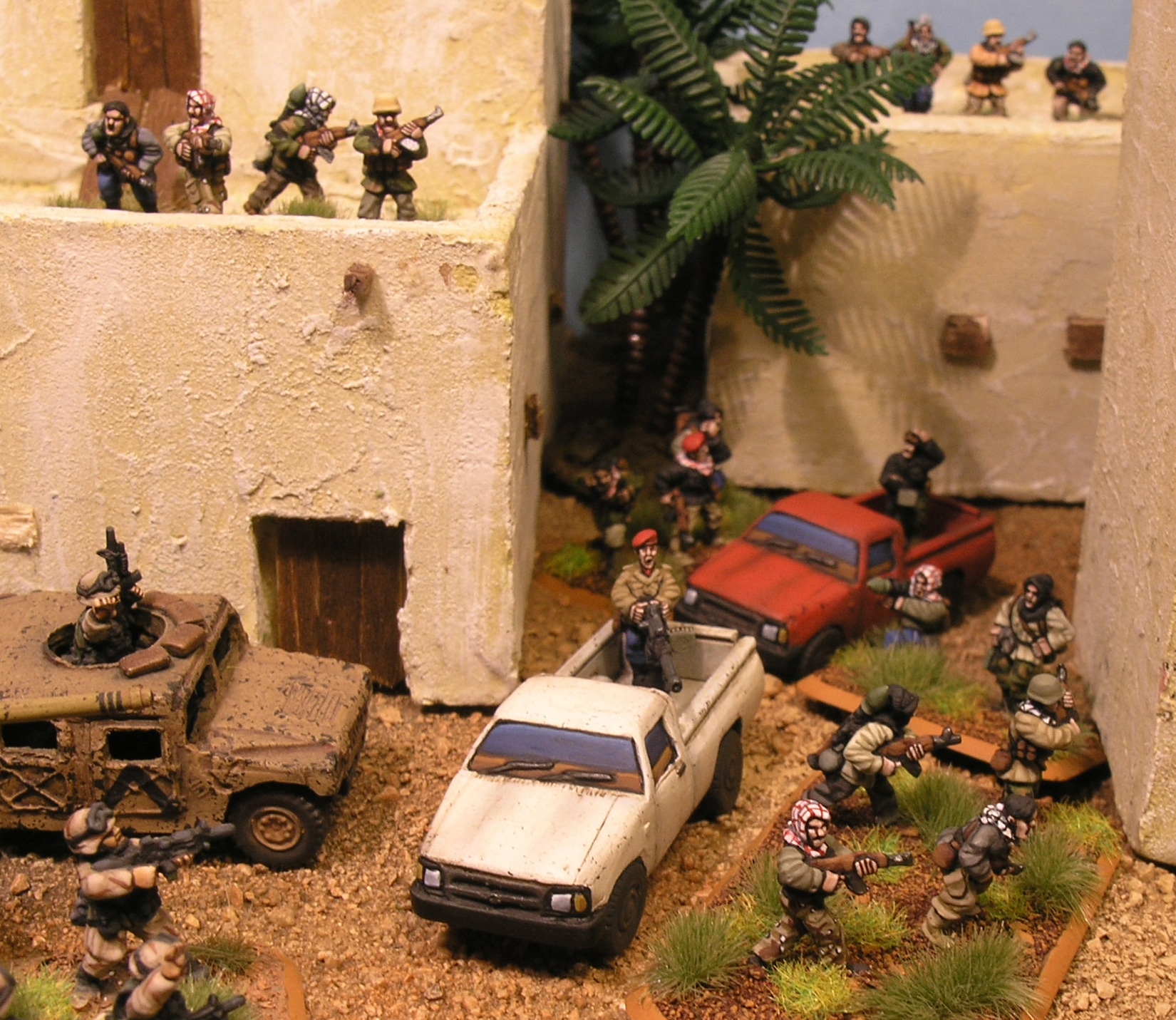Over the last years I have been commissioned to paint plenty of miniatures featuring the Middle-East conflicts we have sadly seen in the TV lately. I am the first one who consider that there might be something wrong with this… when these conflicts are very close in time and space. But let be honest. As wargamers we do not require much motivation to start collecting and painting tiny miniatures. Just a book, a movie…or the BBC channel. We like to simulate any conflict and play one of our “chess games”. And this has nothing to do either with the war per se nor with our political viewpoint. In this regard, and taking into account that I am also an airsoft player, I have been asked several times something like “why do you like war?” or “why do you support war?” My thunderstruck face is always followed by a “Sorry, what?” and then I try to explain what we do here… Honestly, it is like saying that people who likes action movies, video games or who likes sports such as fencing, archery, boxing, and so on also support violence and war. For us, this is only a strategy game and a manifestation of our love for history (I regret to inform you that sadly our history can be told only throughout wars). It is a competition against an opponent in equal conditions to see who is the smarter one. You, the reader, are probably a wargamer too. What do you think about this? Have you been ever asked the same question?
Nevertheless, I wanted to share with you some painting tips. In the following lines you will find a short historical introduction (basically based on Wikipedia) followed by some painting tips and a color chart featuring five different factions of Middle-East conflicts: Afghans (Taliban), militiamen, Syrian, Peshmerga and Professional Military Contractors (PMC). All these miniatures are 15mm and are from Khurasan miniatures. In addition, I have included a small historical article in this post which I wrote long time ago for an extinct Spanish wargames magazine about an US army operation during the Iraq War. Unfortunately, this is only in Spanish; although you can use google translator to check it out. Or just enjoy the battle scenes. In this other case, the miniatures are mostly from Peter Pig and some vehicles from Old Glory.
Afghan
During the last part of the XXth century Afghanistan has been shaken by constant military conflicts. In 1978, the rise of the communism resulted in a civil war between the communist government and the guerrilla muhjahideen. The initial support of the Soviet Union to the government finally turned out in the entrance of the СССР in the civil war. Meanwhile, USA braced the guerrilla. Nine years later (1989), the Soviet Union withdrew and abandoned Afghanistan although continued to support the communist government. Without the Soviet troops in Afghanistan, the civil war escalated soon. In 1990 the state officially became Islamic and the communism was abandoned. However, this as not enough to suffocate the conflict. Soon another movement appeared in 1994: the Taliban, a political-religious force, who finally took control of Kabul, stablishing the Islamic Emirate of Afghanistan. Their remaining enemies formed the Northern alliance and fought back. However, the Taliban, supported by the neighbor countries, easily maintained the power. From 1996 to 2001 the al-Qaeda started to operate inside Afghanistan, resulting in the September 11 attacks in the United States supposedly orchestrated by Osama bin Laden. Several weeks later, USA and UK launched the “Operation Enduring Freedom” and started bombarding Afghanistan while supporting the Northern alliance with the deployment of several thousands of soldiers. After overthrowing the Taliban government, an “International security Assistance Force (ISAF)” was established by the UN in order to help to the new government. On the other hand, after losing control of the country, the Taliban began an insurgency to regain it. Thirteen years later, the US war in Afghanistan finished in 2014; although thousands of NATO soldiers continue to help and provide security in the country nowadays.
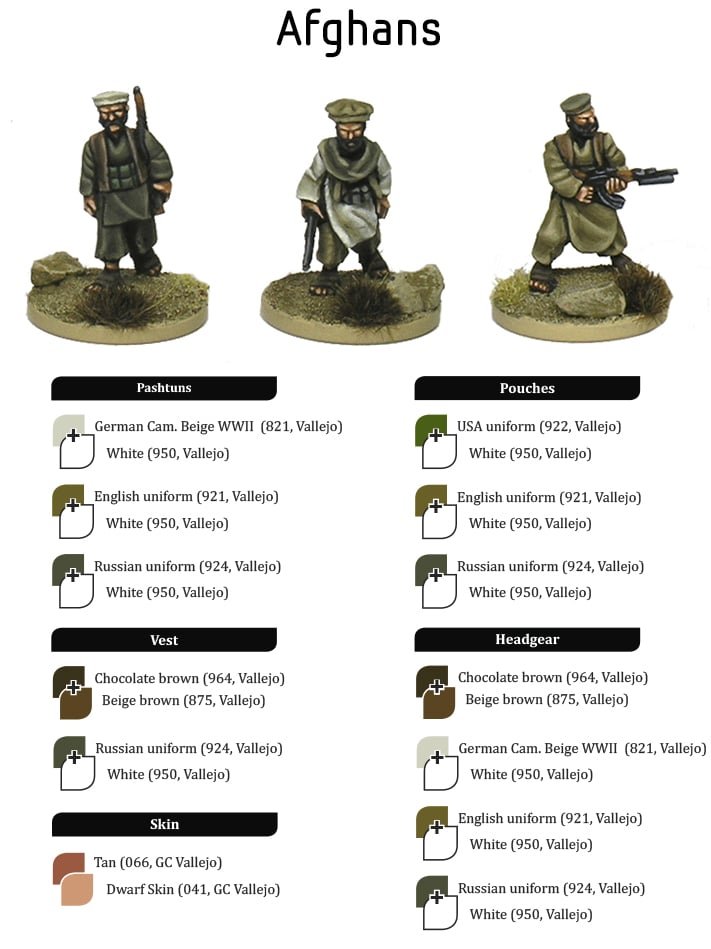 Guerrilla groups such as Taliban are irregular soldiers; and therefore, they are mainly dressed in civilian clothes such as the typical payraan tumbaan (loose trousers and long shirt without bottoms, both of the same color), kurta (long shirt) or / and vest. Since these are civilian clothes, we can use any color. However, the range is limited to white and different brown colors. We can combine these in different ways to reinforce the irregular feature of these forces. The same is applied when painting the headgear, including turbans or the classical pakol. A painting tip: we can easily increase the variety of brown colors even when we do not have many by applying different highlights. That is, we can use the same base brown color (let say, chocolate brown) but then use different colors when painting the highlights (i.e. mix the chocolate brown either with white OR yellow).
Guerrilla groups such as Taliban are irregular soldiers; and therefore, they are mainly dressed in civilian clothes such as the typical payraan tumbaan (loose trousers and long shirt without bottoms, both of the same color), kurta (long shirt) or / and vest. Since these are civilian clothes, we can use any color. However, the range is limited to white and different brown colors. We can combine these in different ways to reinforce the irregular feature of these forces. The same is applied when painting the headgear, including turbans or the classical pakol. A painting tip: we can easily increase the variety of brown colors even when we do not have many by applying different highlights. That is, we can use the same base brown color (let say, chocolate brown) but then use different colors when painting the highlights (i.e. mix the chocolate brown either with white OR yellow).
Middle-East militiamen
There is not much to say about these militiamen that we do not know yet. We can essentially find these irregular soldiers in any conflict in the Middle-East, from the Iraqi insurgency after the US invasion of Iraq to the recently created Islamic State or Dā’ash, or in the Free Syrian Army. Mostly armed with the omnipresent Ak47 and other Russian gear, sometimes they can even carry captured Western weapons.
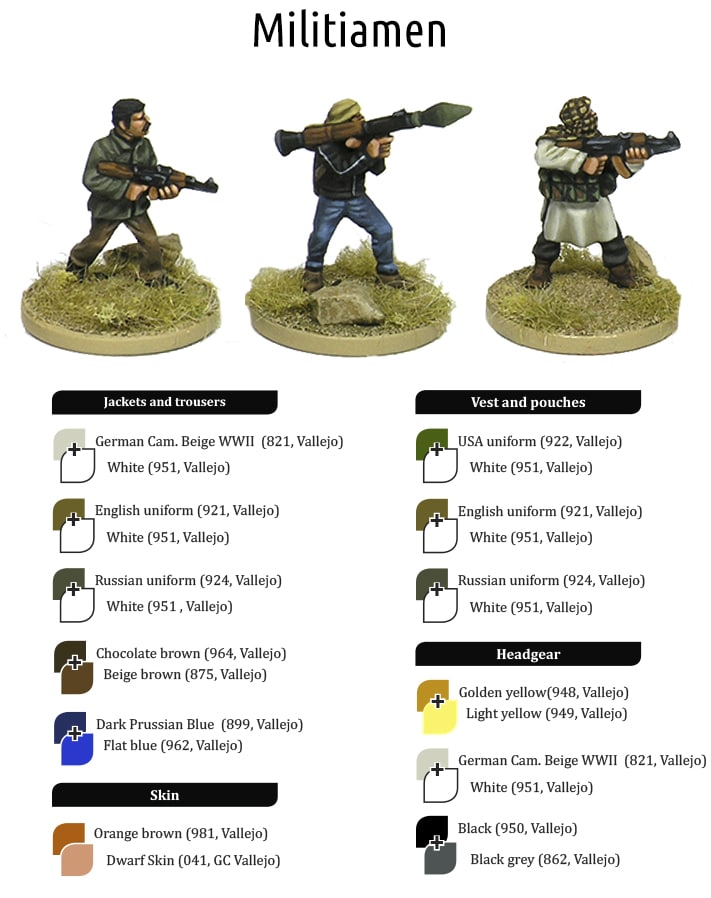 These miniatures are very grateful to paint since “everything goes”. They are irregulars; and therefore, we can use any color to paint the clothes, from jeans to tracksuit; and we are also free to paint full metal guns (totally black, featuring the modern AK74) or guns with wooden stock and handguard like in the classic Ak47, for example. I have to confess that I really like to paint…tracksuits: first paint the cloth in any color and then just paint a couple of fine white lines along the sleeves of the jacket or pant legs.
These miniatures are very grateful to paint since “everything goes”. They are irregulars; and therefore, we can use any color to paint the clothes, from jeans to tracksuit; and we are also free to paint full metal guns (totally black, featuring the modern AK74) or guns with wooden stock and handguard like in the classic Ak47, for example. I have to confess that I really like to paint…tracksuits: first paint the cloth in any color and then just paint a couple of fine white lines along the sleeves of the jacket or pant legs.
Peshmerga (“He who confronts death”)
The autonomous region of Iraqi Kurdistan is defended by the –irregular- military forces so called Peshmerga, since the Iraqi army is not allowed from entering in this region. During the Iraq War, the Peshmerga helped the coalition forces in their fight against Hussein’s military forces and later on against al-Qaeda. In the recent years, after the rising of the Islamic State, Peshmerga and other Kurdish groups are bloody fighting against the IS threat in Iraq and Syria. Due to the special condition of the Iraqi Kurdistan region, their arsenal is pretty limited and mostly relies in captured equipment. However, since the ISIS offensive in 2014, they are receiving some light supplies from different countries.
As irregular forces, we can find very different combination of gears. We can recreate this by combining different camos –or just a plain color– in our miniatures. I do not only mean to paint one miniature with camo “A “, and then another miniature with camo “B”. Not only that. We can also mix camouflage patterns in jackets and trousers. We could also paint the vest and helmet with a different pattern. There are many options. One painting tip for the camos: depending on the camo sometimes is advisable to apply a smooth highlight on the camo spots. For example, we can use grey one black spots or a light brown on dark brown ones. By doing this we obtain a “cleaner” effect: the spots are more defined and the camo pattern is easily identified. However, do not abuse of this effect. Remember, apply smooth lights!
Syrian
 As a result of the Arab spring protests, the discontent with the Syrian President Bashar-al-Assad escalated and ended up in a civil war in March of 2011. Although there are several factions involved, we can essentially divide them between the Syrian government (including the Islamic State or Dā’ash) and the Free Syrian Army. The Syrian government is military supported by Russia and Hezbollah; meanwhile the NATO lately attacked the IS by air and sea. It is noteworthy to mention that both groups have been accused of severe human rights violations, triggering one of the largest immigrations crisis we have ever seen.
As a result of the Arab spring protests, the discontent with the Syrian President Bashar-al-Assad escalated and ended up in a civil war in March of 2011. Although there are several factions involved, we can essentially divide them between the Syrian government (including the Islamic State or Dā’ash) and the Free Syrian Army. The Syrian government is military supported by Russia and Hezbollah; meanwhile the NATO lately attacked the IS by air and sea. It is noteworthy to mention that both groups have been accused of severe human rights violations, triggering one of the largest immigrations crisis we have ever seen.
Syrian soldiers are dressed both in old Soviet Union uniforms and in more modern gear. Therefore, we can follow exactly the same idea we discussed about the Peshmergas, and combine different patterns of camouflages.
Private Military Company (PMC) or US Spec Ops
Perhaps better known as “security contractors” or just “contractors”, are corporate-type soldiers that provide security or combat services. It is very interesting to mention that the UN consider PMCs as mercenaries and do not approve them, although it is a bit worthless since some countries such as Russia, UK, China and USA did not sign this convention. Their services are very diverse, from military trainers or advisors to bodyguards or security providers. And sometimes, they are even used as offensive forces. They are war veterans with their own gear, and actually they might look very similar to some US army special ops. The Typical loadout is geared more towards civilian clothing with body armor underneath. Note that technically all contractors are “non-combatants”, and therefore, in principle they are not allowed to use camo gear.
Like the Middle-East militiamen, we have some freedom when painting these miniatures. Since they resemble civilians we can use any color for the clothes, although they normally wear tan or camel (good “camo” for the arid regions). While I widely varied the T-shirt color, from white to blue; I essentially used the same color for trousers and vest: English uniform (921, Vallejo) highlighted with white. To add a little bit more of variation in some cases the base color was a mixture of English uniform and chocolate brown, which resulted in a darker tone. In addition, we can also paint some gun elements, such as ACOGs, rails, stock and so forth in tan/camel. The idea is to simulate that each veteran has personally customized his gun.
Vehicle gallery
Here you can see some 15mm vehicles either from Khurasan minaitures, Peter Pig or QRF, basically featuring the Syrian army or arab militias.
Task Force “Iron Dukes”
Preludio
A comienzos de Abril del 2003 el 1º Brigade Combat Team (BCT) del ejército estadounidense, formado mayoritariamente por tres batallones del Regimiento de infantería 327º, toma el control de An Najaf, asegurándose así una importante plaza sobre el Éufrates. Sin embargo, tras un año de ocupación, el 4 de Abril del 2004 la tensión acumulada termina por aflorar y los insurgentes atacan a las fuerzas de la coalición ubicadas en la base de Al-Ándalus, entre las que se encuentran tropas españolas: elementos del Regimiento de infantería mecanizada “Saboya 6” y del Regimiento de caballería ligera acorazada “Farnesio”. En su ayuda acudiría la 1st Armored Division Task Force (2d Battalion, 37th Armor) estadounidense, restableciendo el orden. No obstante, esta ciudad aún será protagonista de una tercera batalla en el 2007 entre insurgentes y las Fuerzas de Seguridad Iraquí (IFS).
La Task Force “Iron Dukes”
El 28 de Mayo de 2003 los Iron Dukes (2-37 Armor) comienzan su actividad en tierras iraquíes, acompañados de un destacamento de caballería ligera y una compañía de carros del 2d Armored Cavalry Regiment “Dragoons” (2d ACR). Durante diez meses se dedicarán a misiones de mantenimiento, como el entrenamiento de la policía iraquí y la formación de un batallón del cuerpo de defensa civil.
Entre el 4 y 10 de Abril del 2004 son protagonistas de varios combates en Bagdad, seguidos de otros en Al Kut y Ad-Diwaniyah, que no acabarían hasta el 17 de Abril. El 22 de Abril los Iron Dukes reciben la misión de tomar el control en An Najaf y Al Kufa (dos ciudades hermanas prácticamente unidas), donde deberán destruir a las milicias congregadas y restaurar el orden, facilitando así la transición de la autoridad al nuevo gobierno Iraquí y de la seguridad a las recién creadas Fuerzas de seguridad iraquí (IFS).
El 28 de Abril comienzan los combates en An Najaf, donde concentran un potente arsenal: dos compañías blindadas de M1A1 Abrams (denominadas Team Crusader y Team Aggresor), dos escuadrones de caballería ligera (compuestos por el 1º escuadrón, Apache Troop, y el 3º escuadrón, Iron Troop), una compañía de Stryker (el Iron Team de la 2d ACR), una batería de artillería de Paladines (Assasin), una pequeña compañía de policía militar (Warbear), una compañía ligera de ingenieros (84th CEC) y el HQ de la compañía. También contarían con un nutrido apoyo aéreo, formado por OH-58D Kiowa Warriors, cañoneras AC-130 y F-16 Falcons.
La Task Force divide sus fuerzas en 4 columnas, que se desplazarían con una distancia de 40km de distancia de por medio, apoyándose en tres bases de operaciones avanzadas o FOB’s: la FOB Hotel, situada al norte en las afueras de An Najaf, donde se situaría la artillería y un equipo de carros. La FOB Duke, localizada en pleno desierto, desde donde se coordinaría el ataque. Y por último, el resto de fuerzas se ubicarían en la FOB Baker y Golf (también conocida como base Al-Ándalus para las tropas españolas allí desplegadas), en el corazón de An Najaf.
Las fuerzas insurgentes, formadas por el ejército de Madhi e instigadas por el clérigo Moqtada Al-Sadr, estarían formadas mayoritariamente por milicia sin ningún tipo de entrenamiento, cuyas acciones se reducirían a esporádicos ataques realizados conjuntamente con patrullas de civiles. No obstante, cuentan con cuatro compañías de milicianos adiestrados: dos con un rol defensivo, desplegadas en los alrededores del Santuario de Ali y la mezquita de Kufa, y otras dos ofensivas, listas para saltar sobre las tropas de la coalición. No dudan en utilizar mezquitas y colegios como depósitos de armas y bases para el fuego de mortero.
A pesar de la aparente sencillez de la misión, esta se tornaría harta complicada, pues los americanos han de extremar las precauciones para no dañar los sitios sagrados ocupados por las milicias: 400 milicianos ocupan el Santuario de Ali (símbolo religioso para 5 millones de Chiitas y sede de la Ayatola Sistani) y otros 400 ocupan la mezquita de Kufa.
Material y métodos
La táctica americana se centra en tres objetivos: en primer lugar la milicia, la cual no se espera que soporte demasiada presión, a pesar de su elevada moral. En segundo lugar, la caza de líderes iraquíes, tratando de descabezar el ejército de Madhi y romper así la estabilidad entre las tropas insurgentes. Por último, la localización y destrucción de depósitos de armas, con el intento de bloquear o romper las líneas de suministro. Esto consiguió desconcertar a los milicianos, obligándoles a priorizar cada movimiento, lo que permitió a los americanos tener la iniciativa en todo momento.
El principal vehículo blindado involucrado fue el M1A1 Abrams, cuyo cañón de 120mm cebado con munición anti-tanque multipropósito (MPAT), anti-tanque explosiva (HEAT) o de reducción de obstáculos (OR) causaría tremendos efectos psicológicos sobre las concentraciones enemigas, a la vez que permitiría crear puntos de entrada para la infantería en edificios y eliminar obstáculos. Así mismo, la ametralladora coaxial M240 y la de calibre 50 ofrecerían un admirable fuego de cobertura. Ésta última cebada con munición incendiaria (API) sería devastadora, pero causaría demasiados daños colaterales, quedando su uso restringido a objetivos inflamables y disuasorios, como las palmeras. Junto a estos carros operarían dos modelos de HMMWV o Humvee, los M1114 y M1025 (con mayor blindaje), ofreciendo un importante fuego de apoyo con sus ametralladoras de calibre 50 y lanzagranadas.
Al tratarse un batallón blindado carecían de francotiradores, los cuales juegan un papel, si no crucial, bastante importante en el combate urbano. Así, deciden crear sus propios tiradores, integrandolos con francotiradores profesionales pertenecientes a las fuerzas de caballería ligera que acompañan a los Iron Dukes. La dinámica seguida consistía en limpiar todos los edificios de un área, para desplegar a continuación los equipos de tiradores, continuando el resto de las fuerzas su camino. El objetivo fundamental de estos equipos se tornará en eliminar equipos de RPG iraquíes, normalmente situados sobre los techos de casas, muros de mezquitas y minaretes.
El apoyo aéreo tuvo un importante papel, tanto militar como psicológico. Pronto los iraquíes aprendieron a temer el sonido de las cañoneras AC-130 o el de los misiles Hellfire disparados por los Kiowa Warriors. Estos ataques obligaban a los insurgentes a dirigirse hacia el interior de la ciudad, siendo seguidos por vehículos aéreos no tripulados (UAV) para localizar y atacar las nuevas concentraciones enemigas, sin darles un respiro. Estos UAV también fueron utilizados, con bastante éxito, para localizar los nidos de morteros y cualquier elemento logístico. La artillería, de la mano de los Paladines, tuvo su lugar también llegándose a utilizar hasta cinco tipos distintos de munición, mostrándose especialmente útiles las Copperhead para destruir búnkeres y fortificaciones hechas con troncos de palmeras.
La Task Force además contó con otro tipo de armas, que si no letales, fueron muy útiles, tales como equipos de psicología táctica (TPT), equipos de asuntos civiles (CA), ingenieros y equipos con perros para detectar bombas. Destaca una fuerza de contraterrorismo iraquí, jugando una importante función en el registro de sitios sagrados, como las mezquitas, lugar prohibido para los infieles de la coalición, llegando a encontrar un importante alijo con RPG, AK-47, morteros y granadas.
La batalla
El 22 de Abril, bajo el abrigo de la oscuridad de la noche, las fuerzas de los Iron Dukes toman posiciones en los FOB’s Hotel, Golf y Baker, relevando a las fuerzas de coalición allí desplegadas. Antes de que las fuerzas del ejército de Mahdi pudieran darse cuenta de lo que estaba ocurriendo, la Task Force se infiltra ampliamente con una treintena de M1A1 Abrams y un centenar de HMMWVs.
Deciden ensanchar su área de influencia y organizan patrullas. Sin embargo, éstas se ven envueltas en constantes emboscadas tras salir de la relativa seguridad de los FOB’s. En consecuencia, organizan equipos de combate (Quick Reaction Forces), formados por una sección o pelotón de carros, para dar cobertura y destruir posibles células enemigas. Así, ante una emboscada la patrulla se detiene y trata de asegurar un perímetro, a la espera de la llegada del QRF, lo cual podía durar hasta varias horas.
Durante el mes de Mayo los americanos logran aislar a los milicianos congregados en Al Kufa del resto del ejército de Mahdi, hasta que finalmente los consiguen reducir a los que serán sus dos últimos reductos: el casco antiguo de An Najaf y la mezquita de Kufa. La presión aumenta sobre los insurgentes y corre el rumor de conversaciones entre el ayatolá sistaní Al-Sadr y los jefes tribales para alcanzar la paz y la marcha de las restantes fuerzas insurgentes. Los americanos no lo dudan y aumentan aun más la presión para forzar esa medida: atacan el corazón de Al Kufa para destruir lo poco que queda de las fatigadas tropas insurgentes. El 30 de Mayo se inicia la Operación Smack-down (golpe bajo), que dividida en tres fases dará el golpe de gracia a las fuerzas insurgentes en Al Kufa.
Operación Smack-down
La primera fase de esta operación tendrá el objetivo de calibrar las posiciones defensivas insurgentes. Para ello reúnen a dos escuadrones de HMMWVs (Apache y Iron troops), que se aproximarán desde el sur, y una compañía de carros M1A1 Abrams (Team Crusader), que se aproximará desde el oeste. Al acercarse a las posiciones defensivas insurgentes empiezan a recibir fuego de fusilería y RPG, el cual es rápidamente contestado. A media noche, una vez cumplida su misión, se retiran.
El 1 de Junio se inicia la segunda fase de esta operación, cuyo objetivo será abrir brechas en las posiciones defensivas. En este ataque intervienen dos compañías de carros M1A1 Abrams (Team Agressor y Crusader) y una de Stryker (Team Iron, de la 2d ACR). Los Team Agressor y Iron se aproximan, con bastantes dificultades, por el sur, buscando despistar al enemigo y atraer sus fuerzas. Cuando se acercan a sus zonas limítrofes marcadas, el Team Crusader entra en acción, atacando por el otro extremo. Durante el ataque, los insurgentes se hacen fuertes en la base de policía y el cementerio y no cesan de hacer fuego desde los muros de la mezquita con ametralladoras pesadas y RPG. Sin embargo, el metódico fuego de los carros M1A1 Abrams comienza a debilitar sus líneas y los americanos consiguen ganar el control del cementerio.
El 3 de Junio se inicia la última fase de la operación, cuyo propósito será la destrucción total de la capacidad ofensiva de los insurgentes. Esta fase incluye el Objetivo Oakland de destruir una posición de morteros de 120mm localizada en un colegio: fuerzas blindadas del Team Crusader se aproximan con sus M1A1 Abrams como distracción, mientras que dos escuadras de HMMWVs del Iron Troop consiguen tomar el colegio, luchando habitación por habitación. Los insurgentes tratan de reagruparse y contraatacar, pero son repelidos por el fuego combinado de los M1A1 Abrams y los miembros del Iron Troop que disparan desde el colegio. En unas horas las tropas americanas reciben la orden del cese de hostilidades: se ha alcanzado un acuerdo que incluye el alto el fuego y el desarme del ejército de Mahdi. La lucha ha acabado tras cinco intensas semanas, con un saldo de un millar de insurgentes muertos y el control de la ciudad santa de nuevo en manos de la coalición.
